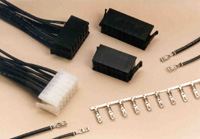 Photo ©1998 AMP INC.
Photo ©1998 AMP INC.All but the simplest connector components, after initial blanking, are formed by simple bending. Channels, boxes, bellows, and other shapes are produced in the same die that makes the initial cut on incoming strip. The strip may be bent at angles ranging from 0 to 180° to produce these shapes. The metal's bending axis can be oriented in any direction relative to the incoming strip, with 90° being the most common.
The contact force is directly proportional to the stress (from deflection) in the contact spring. Unfortunately, there is a trade-off between strength and formability. In any given alloy, increasing yield strength by cold rolling decreases formability. This effect is easily seen in the Figure 3. The preferred measure of formability is the "minimum bend radius" (R), which is the sharpest radius over which the metal can be bent without fracture or significant damage to the tensile surface. Elongation is not used as the criterion for formability because often an alloy with higher elongation exhibits inferior ability to be bent to shape. For strip, an R/t of 2.5 means that the sharpest radius is 2.5 times the thickness(t) of the metal. For example, if R/t is 2.5 and the metal is 0.020" thick, then the sharpest radius that can be used without failure is 0.050" (2.5 x 0.020"). The figure also illustrates the importance of orientation, a concept described more fully in the topic "Directionality of Formability."
 Figure 3. Strength and Formability Trade-off.
Figure 3. Strength and Formability Trade-off.Stronger tempers are not the only way to get higher strength and thus higher contact force. The selection of an alternate material can provide different combinations of properties. The three different strengthening mechanisms which depend on chemical composition are described in the topic "Performance Requirements." Solid solution strengthened alloys provide higher strength than copper in the annealed, highly formable condition. Examples include brass and phosphor bronze. Where even higher strength is required, dispersion- or precipitation-strengthened alloys are available. These alloys tend to have superior formability in the mill-hardened condition, but for optimum formability the precipitation-strengthened alloys can be purchased in the annealed or lightly cold-rolled condition and subjected to a final strengthening heat treatment after forming is complete.
Many alloys can benefit from a low-temperature stress relief heat treatment, which may also improve stress relaxation behavior. All of the thermal and mechanical manipulations will entail an extra cost, which the designer must trade off against the design requirements of the contact. Often there are opportunities to increase the number of contacts per pound of strip by careful and clever design. When final alloy choices are being made, it is best to obtain specific formability data from the potential vendor.
To sum up, when faced with the need for higher strength, try to increase temper in the alloy at hand. When there's not enough formability left in the higher temper, select another alloy.
